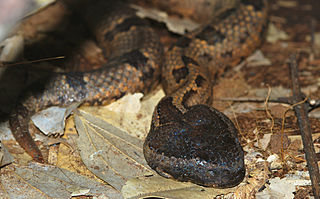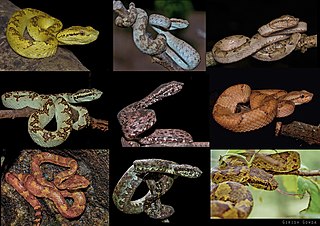
Craspedocephalus strigatus, commonly known as the horseshoe pit viper, is a species of venomous snake in the subfamily Crotalinae of the family Viperidae. The species is endemic to the Western Ghats of India. There are no subspecies that are recognized as being valid.

Ovophis monticola, commonly known as the Chinese mountain pit viper, is a venomous pitviper species found in Asia. Currently, two subspecies are recognized, including the nominate subspecies described here. Recent taxonomic work suggests that most of these should be considered as separate species. IUCN has already evaluated O. m. makazayazaya as Ovophis makazayazaya.

Protobothrops mucrosquamatus is a venomous pit viper species endemic to Asia. Common names include: brown-spotted pit viper, Taiwanese habu and pointed-scaled pit viper. No subspecies are currently recognized. The species was first described by Theodore Cantor in 1839.

Trimeresurus albolabris, the white-lipped pit viper or white-lipped tree viper, is a venomous pit viper species endemic to Southeast Asia.
Trimeresurus cantori, commonly known as Cantor's pit viper or Cantor's pitviper, is a species of venomous snake, a pit viper in the Subfamily Crotalinae of the family Viperidae. The species is endemic to the Nicobar Islands of India. It was named after Theodore Edward Cantor (1809-1860), a Danish naturalist serving as a surgeon with the East India Company in Calcutta. No subspecies are recognized as being valid.

Craspedocephalus gramineus, known as the bamboo pit viper, Indian green pit viper, or common green pit viper, is a venomous pit viper species found in the southern and north eastern parts of India. No subspecies are currently recognized.

Craspedocephalusmalabaricus, commonly known as Malabar pit viper, Malabar rock pit viper, or rock viper, is a venomous pit viper species endemic to the high-moderate elevations of Western Ghats of southwestern India. Recently this species complex was split into three different species, Craspedocephalus malabaricus, Craspedocephalus travancoricus, Craspedocephalus anamallensis.

Trimeresurus popeiorum is a species of venomous pit viper in the family Viperidae. The species is native to northern and northeastern parts of India and Southeast Asia. Common names include: Pope's pit viper, Pope's green pit viper, Pope's tree viper and Pope's bamboo pitviper.

Trimeresurus purpureomaculatus is a venomous pit viper species native to India, Bangladesh and Southeast Asia. Common names include: mangrove pit viper, mangrove viper, and shore pit viper.

Trimeresurus stejnegeri is a species of venomous pit viper endemic to Asia. Two subspecies are currently recognized, including the nominate subspecies described here.

Ovophis okinavensis, commonly known as the hime habu (ヒメハブ), Ryukyu Island pit viper, and the Okinawan pitviper, is a venomous pitviper species found in the Ryukyu Islands of Japan. No subspecies are currently recognized.

Trimeresurus sumatranus is a species of venomous pitviper found in the tropical forests of Indonesia, Malaysia and Thailand. Arboreal by nature, its coloration is pale to neon-green, with some black vertical markings, and a red-tipped tail. As with other vipers, this species has prominent, “keeled” scales, which appear somewhat raised and give the snake a rough-textured appearance. Common names include Sumatran pitviper, Sumatran tree viper, and Sumatran pit viper.
Trimeresurus malcolmi is a venomous pitviper species found in East Malaysia. Common names include: Malcolm's pitviper, Malcolm's tree viper, and Mt. Kinabalu pit viper.
Trimeresurus fasciatus is a venomous pit viper species endemic to Djampea Island, Indonesia. No subspecies are currently recognized. Common names include: banded pitviper and banded tree viper.

Craspedocephalus borneensis, commonly known as the Bornean pit viper, is a venomous pit viper species endemic to the island of Borneo. No subspecies are currently recognized.

Craspedocephalus brongersmai, also known commonly as Brongersma's pit viper, is a species of venomous snake in the subfamily Crotalinae of the family Viperidae. The species is native to islands off the west coast of Sumatra, Indonesia. No subspecies are currently recognized.

Trimeresurus hageni, commonly known as Hagen's pit viper and Hagen's green pit viper, is a species of venomous snake in the subfamily Crotalinae of the family Viperidae. The species is native to Southeast Asia. There are no subspecies that are recognized as being valid.
Garthius chaseni, commonly known as Chasen's mountain pit viper, Chasen's tree viper, and the Kinabalu brown pit viper, is a species of venomous pitviper in the family Viperidae. The species is endemic to the island of Borneo in Malaysia. No subspecies are currently recognized. It is monotypic in the genus Garthius.

Trimeresurus sabahi, commonly known as the Sabah pit viper or Sabah bamboo pitviper, is a venomous pitviper species. If defined narrowly, it is endemic to the island of Borneo. If defined more broadly, it consists of five subspecies found in Southeast Asia.

Trimeresurus insularis or Indonesian pit viper, Lesser Sunda Islands pit viper, Sunda white-lipped pit viper, red-tailed pit viper is a venomous pit viper species found in eastern Java and the Lesser Sunda Islands, Indonesia.
















